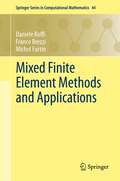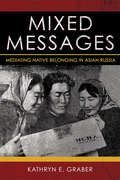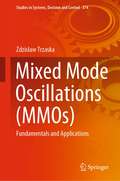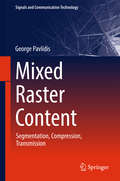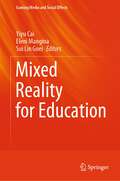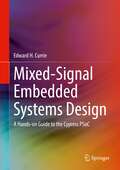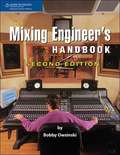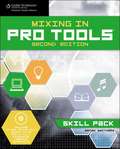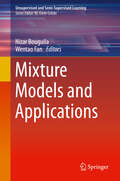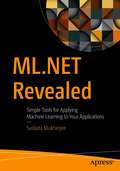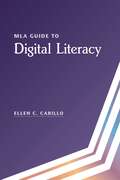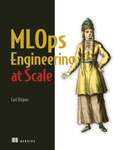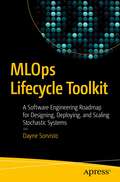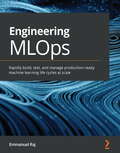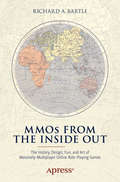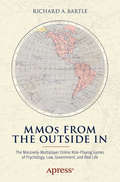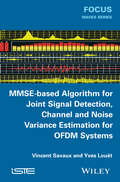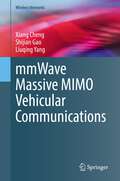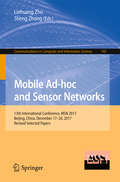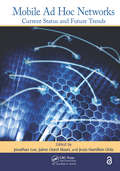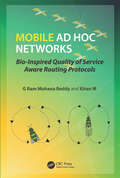- Table View
- List View
Mixed Finite Element Methods and Applications
by Daniele Boffi Franco Brezzi Michel FortinNon-standard finite element methods, in particular mixed methods, are central to many applications. In this text the authors, Boffi, Brezzi and Fortin present a general framework, starting with a finite dimensional presentation, then moving on to formulation in Hilbert spaces and finally considering approximations, including stabilized methods and eigenvalue problems. This book also provides an introduction to standard finite element approximations, followed by the construction of elements for the approximation of mixed formulations in H(div) and H(curl). The general theory is applied to some classical examples: Dirichlet's problem, Stokes' problem, plate problems, elasticity and electromagnetism.
Mixed Messages: Mediating Native Belonging in Asian Russia
by Kathryn E. GraberFocusing on language and media in Asian Russia, particularly in Buryat territories, Mixed Messages engages debates about the role of minority media in society, alternative visions of modernity, and the impact of media on everyday language use. Graber demonstrates that language and the production, circulation, and consumption of media are practices by which residents of the region perform and negotiate competing possible identities. What languages should be used in newspapers, magazines, or radio and television broadcasts? Who should produce them? What kinds of publics are and are not possible through media? How exactly do discourses move into, out of, and through the media to affect everyday social practices? Mixed Messages addresses these questions through a rich ethnography of the Russian Federation's Buryat territories, a multilingual and multiethnic region on the Mongolian border with a complex relationship to both Europe and Asia.Mixed Messages shows that belonging in Asian Russia is a dynamic process that one cannot capture analytically by using straightforward categories of ethnolinguistic identity.
Mixed Methods Social Networks Research
by Silvia Domínguez Betina HollsteinThis edited volume demonstrates the potential of mixed-methods designs for the research of social networks and the utilization of social networks for other research. Mixing methods applies to the combination and integration of qualitative and quantitative methods. In social network research, mixing methods also applies to the combination of structural and actor-oriented approaches. The volume provides readers with methodological concepts to guide mixed-methods network studies with precise research designs and methods to investigate social networks of various sorts. Each chapter describes the research design used and discusses the strengths of the methods for that particular field and for specific outcomes.
Mixed Mode Oscillations: Fundamentals and Applications (Studies in Systems, Decision and Control #374)
by Zdzislaw TrzaskaThis book aims to present a survey of a large class of nonlinear dynamical systems exhibiting mixed-mode oscillations (MMOs). It is a sort of a guide to systems related to MMOs that features material from original research papers, including the author’s own studies. The material is presented in seven chapters divided into sections. Usually, the first sections are of an introductory nature, explain phenomena, and exhibit numerical results. More advanced investigations are presented in the subsequent sections. Coverage includes* Dynamic behavior of nonlinear systems, * Fundamentals of processes exhibiting MMOs,* Mechanism and function of an structure of MMOs patterns, * Analysis of MMOs in electric circuits and systems, * MMOs in chemistry, biology, and medicine, * MMOs in mechanics and transport vehicles, * MMOs in fractional order systems.This is the first extensive description of these topics and the interpretation of analytical results and those obtained from computer simulations with the MATLAB environment. The book provides the readers with better understanding of the nature of MMOs, richness of their behaviors, and interesting applications.
Mixed Raster Content
by George PavlidisThis book presents the main concepts in handling digital images of mixed content, traditionally referenced as mixed raster content (MRC), in two main parts. The first includes introductory chapters covering the scientific and technical background aspects, whereas the second presents a set of research and development approaches to tackle key issues in MRC segmentation, compression and transmission. The book starts with a review of color theory and the mechanism of color vision in humans. In turn, the second chapter reviews data coding and compression methods so as to set the background and demonstrate the complexity involved in dealing with MRC. Chapter three addresses the segmentation of images through an extensive literature review, which highlights the various approaches used to tackle MRC segmentation. The second part of the book focuses on the segmentation of color images for optimized compression, including multi-layered decomposition and representation of MRC and the processes that can be employed to optimize the coding rates of those different layers. Rounding out the coverage, the final chapter examines the segmentation of color images for optimized transmission.
Mixed Reality for Education (Gaming Media and Social Effects)
by Yiyu Cai Eleni Mangina Sui Lin GoeiThis book consists of chapters that present the state-of-the-art research on mixed reality, simulation and serious games with applications in four main educational topics: (1) K-12 STEAM Education; (2) Tertiary/Professional Education; (3) Special Needs Education; and (4) Cultural, Social & Museum Education. The chapters of the book present a multi-facet view on different approaches to deal with challenges that surround the uptake of educational applications of mixed reality, simulations and serious games in various practices. The different approaches highlight challenges and potential solutions and provide future directions for mixed reality, simulation and serious games research, for the design of learning material and for implementation. By doing so, the book is a useful resource for both students and scholars interested in research in this field, for designers of learning material and for practitioners that want to embrace mixed reality, simulation and/or serious games in their education.Chapter "Development of AR Interactive Components for Positive Behavioral Interventions and Supports" is available open access under a Creative Commons Attribution 4.0 International License via link.springer.com.
Mixed-Signal Embedded Systems Design: A Hands-on Guide to the Cypress PSoC
by Edward H. CurrieThis textbook introduces readers to mixed-signal, embedded design and provides, in one place, much of the basic information to engage in serious mixed-signal design using Cypress' PSoC. Designing with PSoC technology can be a challenging undertaking, especially for the novice. This book brings together a wealth of information gathered from a large number of sources and combines it with the fundamentals of mixed-signal, embedded design, making the PSoC learning curve ascent much less difficult. The book covers, sensors, digital logic, analog components, PSoC peripherals and building blocks in considerable detail, and each chapter includes illustrative examples, exercises, and an extensive bibliography.
The Mixing Engineer's Handbook (2nd edition)
by Bobby OwsinskiAppropriate for both novice and experienced recording engineers, this guide walks through the six elements of a mix--balance, panorama, frequency range, dimension, dynamics, and interest--and provides interviews with 22 professional mixers working in different genres. The second edition adds sections on gating, hypercompression, MP3 encoding, and surround sound mixing.
Mixing in Pro Tools: Skill Pack (2nd edition)
by Brian SmithersMixing in Pro Tools: Skill Pack, Second Edition is designed to help you boost your understanding of the art and craft of creating great-sounding mixes in Digidesign's industry-standard DAW Pro Tools. Starting with the basics of essential processors and working up to advanced signal routing and sophisticated sonic manipulation, this book will boost your confidence in your ability to produce polished professional-sounding mixes.
Mixture Models and Applications (Unsupervised and Semi-Supervised Learning)
by Nizar Bouguila Wentao FanThis book focuses on recent advances, approaches, theories and applications related to mixture models. In particular, it presents recent unsupervised and semi-supervised frameworks that consider mixture models as their main tool. The chapters considers mixture models involving several interesting and challenging problems such as parameters estimation, model selection, feature selection, etc. The goal of this book is to summarize the recent advances and modern approaches related to these problems. Each contributor presents novel research, a practical study, or novel applications based on mixture models, or a survey of the literature.Reports advances on classic problems in mixture modeling such as parameter estimation, model selection, and feature selection;Present theoretical and practical developments in mixture-based modeling and their importance in different applications;Discusses perspectives and challenging future works related to mixture modeling.
ML for the Working Programmer
by Lawrence C. PaulsonThe new edition of this successful and established textbook retains its two original intentions of explaining how to program in the ML language, and teaching the fundamentals of functional programming. The major change is the early and prominent coverage of modules, which the author extensively uses throughout. In addition, Paulson has totally rewritten the first chapter to make the book more accessible to students who have no experience of programming languages. The author describes the main features of new Standard Library for the revised version of ML, and gives many new examples, e.g. polynomial arithmetic and new ways of treating priority queues. Finally he has completely updated the references. Dr. Paulson has extensive practical experience of ML, and has stressed its use as a tool for software engineering; the book contains many useful pieces of code, which are freely available (via Internet) from the author. He shows how to use lists, trees, higher-order functions and infinite data structures. He includes many illustrative and practical examples, covering sorting, matrix operations, and polynomial arithmetic. He describes efficient functional implementations of arrays, queues, and priority queues. Larger examples include a general top-down parser, a lambda-calculus reducer and a theorem prover. A chapter is devoted to formal reasoning about functional programs. The combination of careful explanation and practical advice will ensure that this textbook continues to be the preferred text for many courses on ML for students at all levels.
ML.NET Revealed: Simple Tools for Applying Machine Learning to Your Applications
by Sudipta MukherjeeGet introduced to ML.NET, a new open source, cross-platform machine learning framework from Microsoft that is intended to democratize machine learning and enable as many developers as possible.Dive in to learn how ML.NET is designed to encapsulate complex algorithms, making it easy to consume them in many application settings without having to think about the internal details. You will learn about the features that do the necessary “plumbing” that is required in a variety of machine learning problems, freeing up your time to focus on your applications. You will understand that while the infrastructure pieces may at first appear to be disconnected and haphazard, they are not. Developers who are curious about trying machine learning, yet are shying away from it due to its perceived complexity, will benefit from this book. This introductory guide will help you make sense of it all and inspire you to try out scenarios and code samples that can be used in many real-world situations.What You Will LearnCreate a machine learning model using only the C# languageBuild confidence in your understanding of machine learning algorithms Painlessly implement algorithms Begin using the ML.NET library softwareRecognize the many opportunities to utilize ML.NET to your advantageApply and reuse code samples from the bookUtilize the bonus algorithm selection quick references available onlineWho This Book Is ForDevelopers who want to learn how to use and apply machine learning to enrich their applications
MLA Guide to Digital Literacy
by Ellen C. CarilloStudents face challenges assessing, responding to, and producing information in today's fast-paced, complex digital landscape. This guide helps students understand why digital literacy is a critically important skill: their education, future careers, and participation in democratic processes rely on it. Hands-on, structured activities give students strategies for evaluating the credibility of sources, detecting fake news, understanding bias, and more. Readings and writing prompts support specific concepts, including how to craft a research question and effectively conduct searches. An appendix contains three sample lesson plans.
MLOps Engineering at Scale
by Carl OsipovDodge costly and time-consuming infrastructure tasks, and rapidly bring your machine learning models to production with MLOps and pre-built serverless tools!In MLOps Engineering at Scale you will learn: Extracting, transforming, and loading datasets Querying datasets with SQL Understanding automatic differentiation in PyTorch Deploying model training pipelines as a service endpoint Monitoring and managing your pipeline&’s life cycle Measuring performance improvements MLOps Engineering at Scale shows you how to put machine learning into production efficiently by using pre-built services from AWS and other cloud vendors. You&’ll learn how to rapidly create flexible and scalable machine learning systems without laboring over time-consuming operational tasks or taking on the costly overhead of physical hardware. Following a real-world use case for calculating taxi fares, you will engineer an MLOps pipeline for a PyTorch model using AWS server-less capabilities. About the technology A production-ready machine learning system includes efficient data pipelines, integrated monitoring, and means to scale up and down based on demand. Using cloud-based services to implement ML infrastructure reduces development time and lowers hosting costs. Serverless MLOps eliminates the need to build and maintain custom infrastructure, so you can concentrate on your data, models, and algorithms. About the book MLOps Engineering at Scale teaches you how to implement efficient machine learning systems using pre-built services from AWS and other cloud vendors. This easy-to-follow book guides you step-by-step as you set up your serverless ML infrastructure, even if you&’ve never used a cloud platform before. You&’ll also explore tools like PyTorch Lightning, Optuna, and MLFlow that make it easy to build pipelines and scale your deep learning models in production. What's inside Reduce or eliminate ML infrastructure management Learn state-of-the-art MLOps tools like PyTorch Lightning and MLFlow Deploy training pipelines as a service endpoint Monitor and manage your pipeline&’s life cycle Measure performance improvements About the reader Readers need to know Python, SQL, and the basics of machine learning. No cloud experience required. About the author Carl Osipov implemented his first neural net in 2000 and has worked on deep learning and machine learning at Google and IBM. Table of Contents PART 1 - MASTERING THE DATA SET 1 Introduction to serverless machine learning 2 Getting started with the data set 3 Exploring and preparing the data set 4 More exploratory data analysis and data preparation PART 2 - PYTORCH FOR SERVERLESS MACHINE LEARNING 5 Introducing PyTorch: Tensor basics 6 Core PyTorch: Autograd, optimizers, and utilities 7 Serverless machine learning at scale 8 Scaling out with distributed training PART 3 - SERVERLESS MACHINE LEARNING PIPELINE 9 Feature selection 10 Adopting PyTorch Lightning 11 Hyperparameter optimization 12 Machine learning pipeline
MLOps Lifecycle Toolkit: A Software Engineering Roadmap for Designing, Deploying, and Scaling Stochastic Systems
by Dayne SorvistoThis book is aimed at practitioners of data science, with consideration for bespoke problems, standards, and tech stacks between industries. It will guide you through the fundamentals of technical decision making, including planning, building, optimizing, packaging, and deploying end-to-end, reliable, and robust stochastic workflows using the language of data science. MLOps Lifecycle Toolkit walks you through the principles of software engineering, assuming no prior experience. It addresses the perennial “why” of MLOps early, along with insight into the unique challenges of engineering stochastic systems. Next, you’ll discover resources to learn software craftsmanship, data-driven testing frameworks, and computer science. Additionally, you will see how to transition from Jupyter notebooks to code editors, and leverage infrastructure and cloud services to take control of the entire machine learning lifecycle. You’ll gain insight into the technical and architectural decisions you’re likely to encounter, as well as best practices for deploying accurate, extensible, scalable, and reliable models. Through hands-on labs, you will build your own MLOps “toolkit” that you can use to accelerate your own projects. In later chapters, author Dayne Sorvisto takes a thoughtful, bottom-up approach to machine learning engineering by considering the hard problems unique to industries such as high finance, energy, healthcare, and tech as case studies, along with the ethical and technical constraints that shape decision making. After reading this book, whether you are a data scientist, product manager, or industry decision maker, you will be equipped to deploy models to production, understand the nuances of MLOps in the domain language of your industry, and have the resources for continuous delivery and learning. What You Will Learn Understand the principles of software engineering and MLOpsDesign an end-to-end machine learning systemBalance technical decisions and architectural trade-offsGain insight into the fundamental problems unique to each industry and how to solve them Who This Book Is For Data scientists, machine learning engineers, and software professionals.
MLOps using Azure Machine Learning: Rapidly build, test, and manage production-ready machine learning life cycles at scale
by Emmanuel RajThis book is for data scientists, software engineers, DevOps engineers, and machine learning developers who want to build, deploy, and maintain ML systems in production efficiently using MLOps principles and techniques. Basic knowledge of machine learning is required.
MMOs from the Inside Out
by Richard A. BartleThis is an astonishing collection of ideas, information, and instruction from one of the true pioneers of Massively-Multiplayer Online Role-Playing Games. MMOs from the Inside Out: The History, Design, Fun, and Art of Massively-Multiplayer Role-playing Games speaks to the designers and players of MMOs, taking it as axiomatic that such games are inspirational and boundless forces for good. The aim of this book is to enthuse an up-coming generation of designers, to inspire and educate players and designers-to-be, and to reinvigorate those already working in the field who might be wondering if it's still all worthwhile. Playing MMOs is about fun, immersion, and identity. Creating MMOs is about imagination, expression, and art. MMOs are so packed with potential that today's examples are little more than small, pioneering colonies on the shore of a vast, uncharted continent. What wonders wait beyond the horizon? What treasures will explorers bring back to amaze us? MMOs from the Inside Out is for people with a spark of creativity: it pours gasoline on that spark. It: Explains what MMOs are, what they once were, and what they could - and should - become. Delves into why players play, and why designers design. Encourages, enthuses, enrages, engages, enlightens, envisions, and enchants. Doesn't tell you what to think, it tells you to think. What you'll learn You'll learn: Myriad ways to improve MMOs - and to decide for yourself whether these are improvements. What MMOs are; who plays them, and why. How MMOs became what they are, and what this means for what they will become. That you have it in you to make MMOs yourself. Who this book is for MMOs from the Inside Out is a book for those who wish to know more about game design in general and MMO design in particular. It's for people who play MMOs, for people who design MMOs, and for people who study MMOs. It's for people with a yearning to see beyond the world around them and to make manifest the worlds of their imagination. Table of Contents Part 1: How Game Developers See MMOs 1. MMO Design Insights 2. MMO Development: Systems and Security 3. MMO Operation: Community and Customer Service 4. Fun, Flow, Immersion, and Presence 5. The Past, Present, and Future of MMOs 6. Understanding MMOs Through Game Studies 7. Player Identity: Who Plays MMOs, Why they Play Them, and How They Play Them 8. The Constraints of Current MMO Production 9. Making a Difference by Reading This Book Part 2: How the World Sees MMOs 10. Understanding the Language of MMOs 11. Society's Demands: A Virtual World's Place in the Real World 12. Society's Concerns: How Non-Gamers See MMO Players 13. The Business of MMOs: How Developers and Players Make Money 14. Government and Law: The Real Legal Issues Around MMOs 15. Morality: Religion and Ethics in MMOs
MMOs from the Outside In
by Richard A. BartleThis follow-up volume to MMOs from the Inside Out is a further collection of bold ideas, information, and instruction from one of the true pioneers of Massively-Multiplayer Online Role-Playing Games. Whereas its predecessor looked at how MMOs can change the world, MMOs from the Outside In: How Psychology, Law, Culture and Real Life see Massively-Multiplayer Role-playing Games looks at how the world can change MMOs - and not always for the better. The aim of this book is to inform an up-coming generation of designers, to alert and educate players and designers-to-be, and to caution those already working in the field who might be growing complacent about society's acceptance of their chosen career. Playing and creating MMOs does not happen in a bubble. MMOs are so packed with potential that those who don't understand them can be afraid, and those who do understand them can neglect their wider impact. Today's examples are little more than small, pioneering colonies on the shore of a vast, uncharted continent. What monsters lurk beyond the horizon? What horrors will explorers bring back to torment us? MMOs from the Outside In is for people with a spark of curiosity: it pours gasoline on that spark. It: * Explains how MMOs are perceived, how they could - and perhaps should - be perceived, and how the can contribute to wider society. * Delves into what researchers think about why players play. * Encourages, enthuses, enrages, engages, enlightens, envisions, and enchants. * Doesn't tell you what to think, it tells you to think. What You Will Learn: * The myriad challenges facing MMOs - and to decide for yourself how to address these challenges. * What MMOs bring to the world that it didn't have before. * How MMOs are regarded, and what this means for how they will be regarded in future. * That playing and designing MMOs has implications for those who don't play or design them. Whom This Book is For: MMOs from the Outside In is a book for those who wish to know more about the wider influence of game design in general and MMO design in particular. It's for people who play MMOs, for people who design MMOs, and for people who study MMOs. It's for people with a yearning to see beyond the worlds of their imagination and to change the world around them.
MMSE-Based Algorithm for Joint Signal Detection, Channel and Noise Variance Estimation for OFDM Systems
by Vincent Savaux Yves LouëtThis book presents an algorithm for the detection of an orthogonal frequency division multiplexing (OFDM) signal in a cognitive radio context by means of a joint and iterative channel and noise estimation technique. Based on the minimum mean square criterion, it performs an accurate detection of a user in a frequency band, by achieving a quasi-optimal channel and noise variance estimation if the signal is present, and by estimating the noise level in the band if the signal is absent. Organized into three chapters, the first chapter provides the background against which the system model is presented, as well as some basics concerning the channel statistics and the transmission of an OFDM signal over a multipath channel. In Chapter 2, the proposed iterative algorithm for the noise variance and the channel estimation is detailed, and in Chapter 3, an application of the algorithm for the free-band detection is proposed. In both Chapters 2 and 3, the principle of the algorithm is presented in a simple way, and more elaborate developments are also provided. The different assumptions and assertions in the developments and the performance of the proposed method are validated through simulations, and compared to methods of the scientific literature
mmWave Massive MIMO Vehicular Communications (Wireless Networks)
by Xiang Cheng Shijian Gao Liuqing YangThis book proposes promising mmWave solutions to promoting safe and reliable vehicular communications. The authors include topics such as channel estimation, multi-user transceiver design, and advanced index modulation. For channel estimation, unique channel properties and hybrid structures are first introduced, followed by the development of a doubly-sparse doubly-selective channel estimator. For multi-user transceiver design, the concept of hybrid block diagonalization (HBD) is first introduced, followed by a generic HBD-based transceiver design to maximize the system capacity. For advanced index modulation, the generalized beamspace modulation for uplink multi-user scenarios are first introduced, followed by the precoded beamspace modulation for the downlink. Finally, this book discusses open problems and future research directions to inspire further studies in the field of mmWave vehicular communications.
Mob School Survivor: The Creeper Diaries, An Unofficial Minecrafter's Novel (Creeper Diaries #1)
by Greyson Mann Amanda BrackThe launch of an exciting, hilarious new series narrated by an underdog every Minecrafter can relate to. Gerald Creeper Jr. is a self-proclaimed pacifist (which, by the way, has nothing to do with a pacifier), but he finds himself in the war zone when he starts his first year at Mob Middle School. At his new school, every monster in the Overworld is jockeying for power, and the skeletons seem to have it out for him. Armed with a 30-day plan (he can thank his mom’s self-help obsession for that), Gerald makes it his mission to use his brains-instead of his blasts-to survive the school year. It all starts with: Day 1: Come up with a nickname. (Gerald is not gonna cut it.) Day 2: Keep a low profile. (Not easy when your new best friend is a super bouncy slime!) Day 3: Avoid being target practice for skeletons, and somehow get in with super-popular Eddy Enderman. (Easier said than done.) The first book in this laugh-out-loud funny, heavily illustrated, diary format series for Minecrafters follows the most misunderstood hostile mob in the Overworld. It’s not easy being green . . . or explosive!
Mob School Swap: The Creeper Diaries, An Unofficial Minecrafters Novel, Book Eight (The Creeper Diaries #8)
by Greyson MannWhen Mom decides the Creeper family should take part in a student-exchange program, Gerald knows his house is going to get a lot more crowded. But he's horrified when the mob they're hosting turns out to be human. Now Gerald has to bring his new "brother" to school with him. But how can a creeper be cool showing up at Mob Middle School with a human at his side? Gerald is sure this is going to be his longest semester ever. Can he make the best of it, or will it all end in a blast of embarrassment?
Mobile Ad-hoc and Sensor Networks: 13th International Conference, Msn 2017, Beijing, China, December 17-20, 2017, Revised Selected Papers (Communications In Computer And Information Science #747)
by Liehuang Zhu Sheng ZhongThis book constitutes the refereed proceedings of the 13th International Conference on Mobile Ad-hoc and Sensor Networks, MSN 2017, held in Beijing, China, in December 2017. The 39 revised full papers presented were carefully reviewed and selected from 145 submissions. The papers address issues such as multi-hop wireless networks and wireless mesh networks; sensor and actuator networks; vehicle ad hoc networks; mobile social network; delay tolerant networks and opportunistic networking; cyber-physical systems; internet of things; system modeling and performance analysis; routing and network protocols; data transport and management in mobile networks; resource management and wireless QoS provisioning; security and privacy; cross layer design and optimization; novel applications and architectures.
Mobile Ad Hoc Networks: Current Status and Future Trends
by Jonathan LooGuiding readers through the basics of these rapidly emerging networks to more advanced concepts and future expectations, this book examines the most pressing research issues in Mobile Ad hoc Networks (MANETs). Leading researchers, industry professionals, and academics provide an authoritative perspective of the state of the art in MANETs. The book includes surveys of recent publications that investigate key areas of interest such as limited resources and the mobility of mobile nodes. It considers routing, multicast, energy, security, channel assignment, and ensuring quality of service.
Mobile Ad Hoc Networks: Bio-Inspired Quality of Service Aware Routing Protocols
by G Ram Reddy Kiran MIn recent years, a lot of work has been done in an effort to incorporate Swarm Intelligence (SI) techniques in building an adaptive routing protocol for Mobile Ad Hoc Networks (MANETs). Since centralized approach for routing in MANETs generally lacks in scalability and fault-tolerance, SI techniques provide a natural solution through a distributed approach for the adaptive routing for MANETs. In SI techniques, the captivating features of insects or mammals are correlated with the real world problems to find solutions. Recently, several applications of bio-inspired and nature-inspired algorithms in telecommunications and computer networks have achieved remarkable success. The main aims/objectives of this book, "Mobile Ad Hoc Networks: Bio-Inspired Quality of Service Aware Routing Protocols", are twofold; firstly it clearly distinguishes between principles of traditional routing protocols and SI based routing protocols, while explaining in detail the analogy between MANETs and SI principles. Secondly, it presents the readers with important Quality of Service (QoS) parameters and explains how SI based routing protocols achieves QoS demands of the applications. This book also gives quantitative and qualitative analysis of some of the SI based routing protocols for MANETs.
